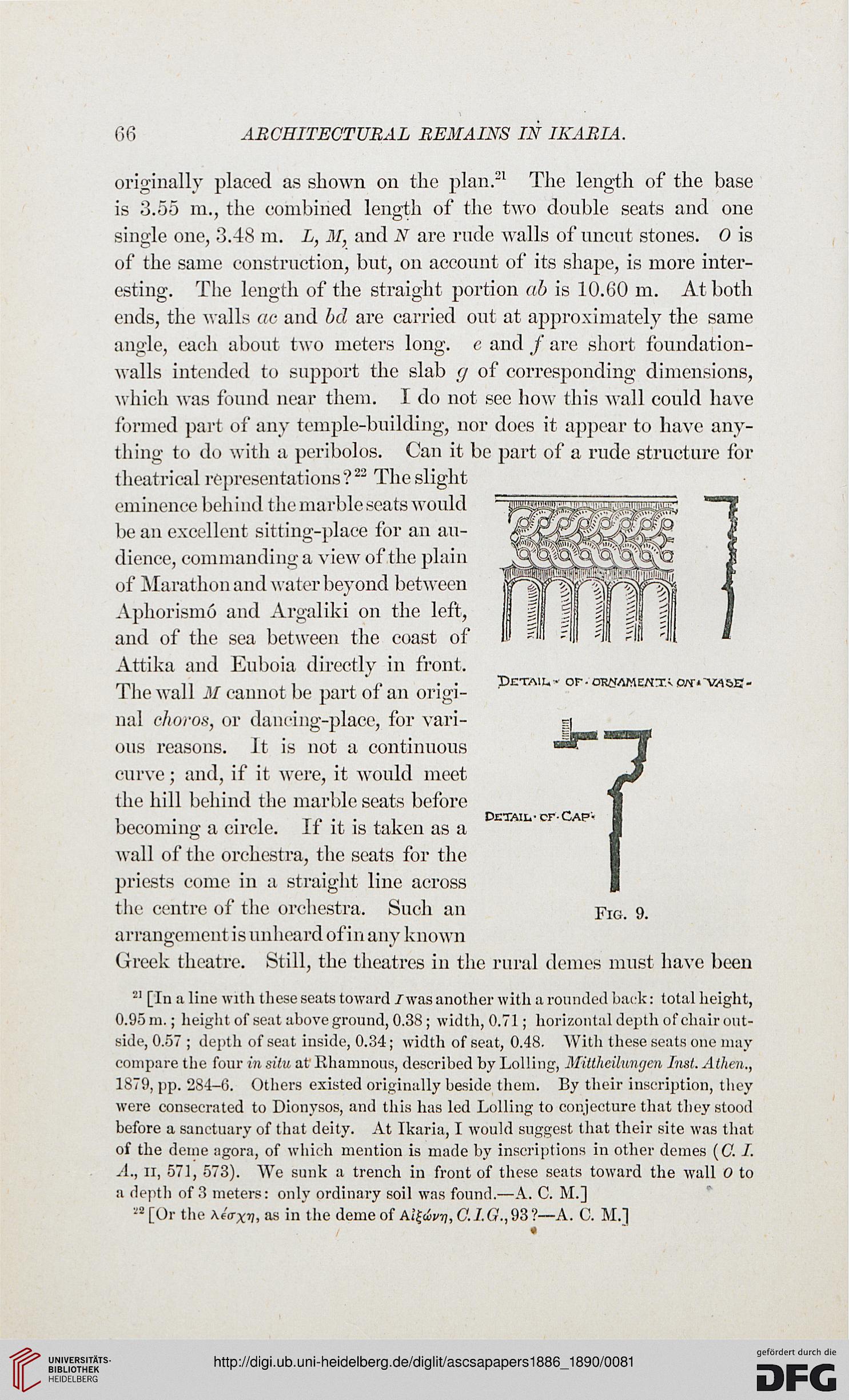66
ARCHITECTURAL REMAINS IN IK ARIA.
originally placed as shown on the plan.21 The length of the base
is 3.55 m., the combined length of the two double seats and one
single one, 3.48 m. L, M, and N are rude walls of uncut stones. 0 is
of the same construction, but, on account of its shape, is more inter-
esting. The length of the straight portion ab is 10.60 m. At both
ends, the walls ae and bd are carried out at approximately the same
angle, each about two meters long, e and / are short foundation-
walls intended to support the slab g of corresponding dimensions,
w hich was found near them. I do not see how this wall could have
formed part of any temple-building, nor docs it appear to have any-
thing to do with a peribolos. Can it be part of a rude structure for
theatrical representations?22 The slight
eminence behind the marble scats would
be an excellent sitting-place for an au-
dience, commanding a view of the plain
of Marathon and water beyond between
Aphorismo and Argaliki on the left,
and of the sea between the coast of
Attika and Euboia directly in front.
The wall M cannot be part of an origi-
nal choros, or dancing-place, for vari-
ous reasons. It is not a continuous
curve; and, if it were, it would meet
the hill behind the marble seats before
becoming a circle. If it is taken as a
wall of the orchestra, the seats for the
priests come in a straight line across
the centre of the orchestra. Such an
arrangement is unheard of in any known
Greek theatre. Still, the theatres in the rural denies must have been
T)ETA!Iv OF ■ OTtfJAMErtTA 0/T< "VrtSE -
Detail-cr-Cap-
Fig. 9.
'-' [In a line with these seats toward / was another with a rounded hac-k: total height,
0.95 m.; height of seat above ground, 0.38 ; width, 0.71; horizontal depth of chair out-
side, 0.57 ; depth of seat inside, 0.34; width of seat, 0.48. With these seats one may
compare the four in situ at Rhamnous, described by Lolling, Mitlhcilungen Inst. Athtn.,
1879, pp. 284-0. Others existed originally beside them. By their inscription, they
were consecrated to Dionysos, and this has led Lolling to conjecture that they stood
before a sanctuary of that deity. At Ikaria, I would suggest that their site was that
of the deme agora, of which mention is made by inscriptions in other denies (C. I.
A., ii, 571, 573). We sunk a trench in front of these seats toward the wall O to
a depth of 3 meters: only ordinary soil was found.—A. C. M.]
•s[Or the \('<rX7), as in the deme of Ai^dvrj, C. 1.67., 93 ?—A. C. M.]
ARCHITECTURAL REMAINS IN IK ARIA.
originally placed as shown on the plan.21 The length of the base
is 3.55 m., the combined length of the two double seats and one
single one, 3.48 m. L, M, and N are rude walls of uncut stones. 0 is
of the same construction, but, on account of its shape, is more inter-
esting. The length of the straight portion ab is 10.60 m. At both
ends, the walls ae and bd are carried out at approximately the same
angle, each about two meters long, e and / are short foundation-
walls intended to support the slab g of corresponding dimensions,
w hich was found near them. I do not see how this wall could have
formed part of any temple-building, nor docs it appear to have any-
thing to do with a peribolos. Can it be part of a rude structure for
theatrical representations?22 The slight
eminence behind the marble scats would
be an excellent sitting-place for an au-
dience, commanding a view of the plain
of Marathon and water beyond between
Aphorismo and Argaliki on the left,
and of the sea between the coast of
Attika and Euboia directly in front.
The wall M cannot be part of an origi-
nal choros, or dancing-place, for vari-
ous reasons. It is not a continuous
curve; and, if it were, it would meet
the hill behind the marble seats before
becoming a circle. If it is taken as a
wall of the orchestra, the seats for the
priests come in a straight line across
the centre of the orchestra. Such an
arrangement is unheard of in any known
Greek theatre. Still, the theatres in the rural denies must have been
T)ETA!Iv OF ■ OTtfJAMErtTA 0/T< "VrtSE -
Detail-cr-Cap-
Fig. 9.
'-' [In a line with these seats toward / was another with a rounded hac-k: total height,
0.95 m.; height of seat above ground, 0.38 ; width, 0.71; horizontal depth of chair out-
side, 0.57 ; depth of seat inside, 0.34; width of seat, 0.48. With these seats one may
compare the four in situ at Rhamnous, described by Lolling, Mitlhcilungen Inst. Athtn.,
1879, pp. 284-0. Others existed originally beside them. By their inscription, they
were consecrated to Dionysos, and this has led Lolling to conjecture that they stood
before a sanctuary of that deity. At Ikaria, I would suggest that their site was that
of the deme agora, of which mention is made by inscriptions in other denies (C. I.
A., ii, 571, 573). We sunk a trench in front of these seats toward the wall O to
a depth of 3 meters: only ordinary soil was found.—A. C. M.]
•s[Or the \('<rX7), as in the deme of Ai^dvrj, C. 1.67., 93 ?—A. C. M.]




